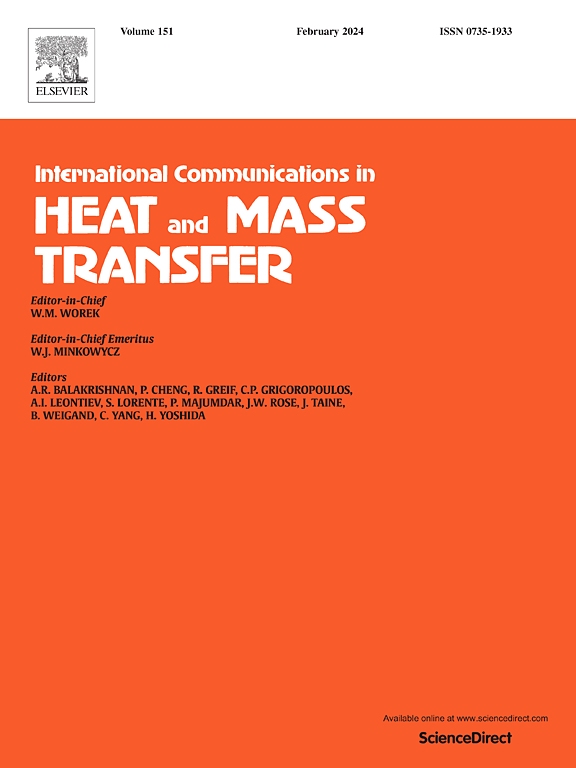Entropy generation and heat-mass transfer analysis in two-phase immiscible micropolar and Jeffrey fluids under an inclined magnetic field and multiple slip conditions in a porous channel
IF 6.4
2区 工程技术
Q1 MECHANICS
International Communications in Heat and Mass Transfer
Pub Date : 2025-04-05
DOI:10.1016/j.icheatmasstransfer.2025.108846
引用次数: 0
Abstract
The efficient management of heat and mass transfer in immiscible non-Newtonian fluids is a critical challenge in advanced engineering systems, such as heat exchangers, chemical reactors, and biomedical devices. Motivated by the present need to enhance energy efficiency and reduce entropy generation in the systems involving complex fluid interactions, in this work, the authors have investigated the entropy generation, flow dynamics, and thermal and concentration profiles of immiscible micropolar and Jeffrey fluids in a horizontal porous channel. The analysis of combined influences of thermal radiation, magnetic field, thermal slip, velocity slip and diffusion slip on the immiscible fluid’s temperature, velocity and concentration distribution, and entropy generation during the flow of non-miscible fluids via a horizontal channel occupied with porous, are the main objective of the present model. These kind of configuration rarely explored in prior research. The immiscible micropolar and Jeffrey fluids’ velocity, temperature distribution, and concentration all were determined by finding the closed form solutions of the associated governing fluid flow equations with the help of classical method. The present work assumes steady, incompressible, and laminar flow with immiscible layers separated by a sharp interface and employs the Darcy’s and Brinkman model for the porous region. The graphical results reveal several novel findings, including a 20% reduction in entropy generation with increased porosity and a 15% improvement in heat transfer efficiency due to thermal slip effects. Additionally, the temperature profile peaks at the fluid interface, showcasing the dominance of interfacial heat exchange, while Jeffrey fluids exhibit 25% higher concentration profiles compared to micropolar fluids due to their relaxation dynamics. This study fills a significant research gap by analyzing the synergistic effects of immiscibility, non-Newtonian rheology, and porous media under multiple external influences—an area neglected in previous work. The findings offer practical insights into optimizing energy-efficient designs for chemical processing, petroleum recovery, polymer extrusion, and biomedical systems. This work’s novelty is found in its thorough examination of entropy generation and heat/mass transfer mechanisms in immiscible fluid systems, highlighting the interplay of interfacial dynamics, slip conditions, and porous resistance in enhancing thermal performance and minimizing energy losses.
求助全文
约1分钟内获得全文
求助全文
来源期刊
CiteScore
11.00
自引率
10.00%
发文量
648
审稿时长
32 days
期刊介绍:
International Communications in Heat and Mass Transfer serves as a world forum for the rapid dissemination of new ideas, new measurement techniques, preliminary findings of ongoing investigations, discussions, and criticisms in the field of heat and mass transfer. Two types of manuscript will be considered for publication: communications (short reports of new work or discussions of work which has already been published) and summaries (abstracts of reports, theses or manuscripts which are too long for publication in full). Together with its companion publication, International Journal of Heat and Mass Transfer, with which it shares the same Board of Editors, this journal is read by research workers and engineers throughout the world.

 求助内容:
求助内容: 应助结果提醒方式:
应助结果提醒方式:


